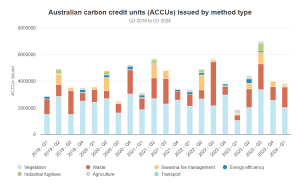ASX has launched three Environmental Futures contracts, marking a significant development for carbon and renewable energy markets in Australia and New Zealand. These new contracts enable participants to price and hedge emissions reduction risk as the economy transitions to a lower carbon footprint. These contracts are the first carbon futures contracts to debut in Australia and New Zealand.
Fee-Free Launch Boosts Carbon Market Liquidity
To foster growth, ASX is offering a temporary fee waiver on all Environmental Futures transactions to build liquidity and encourage early engagement from diverse market participants.
The three futures contracts available for trading on the ASX 24 Market include the following physically delivered:
- Large Generation Certificate (LGC) Futures,
- Australian Carbon Credit Unit (ACCU) Futures, and
- New Zealand Unit (NZU) Futures.
These contracts aim to provide a liquid, transparent forward pricing curve on an annual basis for up to five years. Registered participants can make or take delivery of underlying Certificates or Units at settlement. These instruments can then be surrendered to the government to offset emissions or meet compliance obligations.
Each contract is standardized, with each equaling 1,000 underlying LGCs, ACCUs, or NZUs.
ASX designed its suite of Environmental Futures to meet the growing demand for liquid and transparent carbon credit and renewables trading markets. There has been significant interest in these products from a diverse customer base, including the energy sector, carbon project developers, compliance entities, financial institutions, trade houses, and corporates.
Future-Proofing Australia’s Carbon Market
Daniel Sinclair, ASX Head of Commodities, emphasized the importance of derivatives markets as Australia transitions from a voluntary to compliance carbon market, aligning with other global jurisdictions.
“The transition to clean energy, by definition, is uncertain, and ASX-hosted Environmental Futures will be a key instrument in managing risk and supporting the net zero targets of organisations and policymakers.”
- RELATED STORY: Australia to Merge Compliance and Voluntary Carbon Markets?
Australia’s carbon market is set for significant growth and is poised to become one of the world’s largest producers of carbon credits. Carbon credits, or offsets, represent quantities of abated emissions that fund renewable energy projects and decarbonization efforts. Companies can purchase these credits instead of directly reducing their emissions.
Recent data from the Clean Energy Regulator indicates that about 51% of all ACCUs are now in the registry accounts of safeguard or safeguard-related entities, a volume that could benefit from moving onto the exchange.

At the end of Q1 2024, the Australian National Registry of Emissions Units (ANREU) reported holdings of 38.6 million ACCUs. This marks an increase of 2.4 million ACCUs over the quarter. In Q1 2024, ANREU issued 3.8 million ACCUs, signaling a strong start towards an anticipated record issuance of at least 20 million ACCUs for the year.

For the same period, the number of Safeguard (excluding Safeguard-related) accounts holding ACCUs increased by 11, reaching a total of 54. ACCUs held in these accounts rose to 12 million, an increase of 4.6 million over the quarter.
The volume held by Safeguard entities is likely higher, as other accounts, such as intermediaries and project proponents, may hold ACCUs on their behalf.
Catalyzing Climate Action and Carbon Market Innovation
Established in 2016, Australia’s Safeguard Mechanism requires regulated emitters to either adopt cleaner technologies or buy carbon credits to offset their emissions. This policy allows pollution caps to tighten over time, giving companies a window to adjust their operations to meet emission reduction targets. Additionally, it enables firms to offset emissions by purchasing credits from other polluters with surplus credits.
Back in 2022, Australia’s climate policy advisory has recommended establishing a fully transparent national carbon market. This development could facilitate global carbon trade and potentially merge voluntary and compliance markets.
The federal government has committed to reducing carbon emissions by 43% below 2005 levels by 2030. This new target underscores a stronger commitment to climate action, which could drive significant changes in regulatory and market landscapes.
ASX’s Environmental Futures becomes a key element to that climate commitment. It is also part of a broader ecosystem of current and planned futures and options contracts across electricity, gas, and environmental markets. The new contracts will support Australia and New Zealand’s net zero efforts and clean energy transition.
Environmental Futures could attract new market participants due to their liquidity, enhanced price discovery, and reduced credit risk through central clearing. These futures will provide a standardized price around which liquidity can concentrate, which is particularly important in supporting the ACCU market where certain methods and co-benefits are valued differently.
- READ MORE: Carbon Credit Futures (How Does It Work)
The introduction of these futures contracts underscores ASX’s commitment to supporting the net zero ambitions of businesses and policymakers by providing the necessary tools to manage emissions reduction risks effectively.


